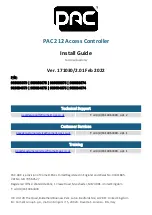
D-Link DWC-2000 User Manual
75
Section 4 - Advanced WLAN Configuration
AP Discovery Methods
The wireless controller and AP can use the following methods to discover each other:
• L2 Discovery
• IP Address of AP Configured in the wireless controller
• IP Address of the wireless controller Configured in the AP
L2/ VLAN Discovery
When the AP and the wireless controller are directly connected or in the same layer 2 broadcast domain and use
the default VLAN settings, the wireless controller automatically discovers the AP through its broadcast of a L2
discovery message. The L2 discovery works automatically when the devices are directly connected or connected
by using a layer 2 bridge. You can enable the discovery protocol on up to 16 VLANs.
By default, VLAN 1 is enabled on the AP, and VLAN 1 is enabled for discovery on the wireless controller. If the
wireless controller and AP are in the same Layer 2 multicast domain, you might not need to take any action to
enable AP discovery. The wireless controller also uses L2/VLAN discovery to find peer controllers within the L2
multicast domain.
The APs process the discovery message only when it comes in on the management VLAN. The APs do not forward
the L2 discovery messages onto the wireless media.
From the wireless controller, you can check the discovery status of APs and peer controllers. To view information
about whether the controller discovered any APs, navigate to the Wireless > Access Point > Discovered AP List
page. The color of MAC address of the Discovered AP List indicating the AP is:
• Green = Managed AP
• Red = Connected Fail AP or AP (D-Link UAP) which is not in local or RADIUS Valid AP Database
• Gray = Unknown AP or Rogue AP
• Orange = Managed AP by peer controller
















































